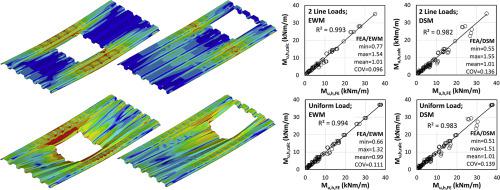当前位置:
X-MOL 学术
›
J. Constr. Steel Res.
›
论文详情
Our official English website, www.x-mol.net, welcomes your
feedback! (Note: you will need to create a separate account there.)
Flexural strength of steel decks with square and rectangular holes: Numerical studies
Journal of Constructional Steel Research ( IF 4.0 ) Pub Date : 2020-09-01 , DOI: 10.1016/j.jcsr.2020.106241 Vitaliy V. Degtyarev
Journal of Constructional Steel Research ( IF 4.0 ) Pub Date : 2020-09-01 , DOI: 10.1016/j.jcsr.2020.106241 Vitaliy V. Degtyarev

|
Abstract Holes in steel roof decks are often provided to allow for the passage of services. Published information on structural properties and design methods of steel deck with holes is limited. To shed light on this topic, a numerical parametric study of the flexural strength of steel decks with single square and rectangular holes was performed. This paper presents results of the study. Nonlinear finite element deck models were developed in ANSYS and validated using published test results. Flexural strengths and load-deflection curves predicted by the developed models showed good agreement with the experimental data. The following parameters were varied in the study: deck type and thickness, hole width and length-to-width ratio, hole location along and across the deck span, and load type. Ultimate moment reductions due to the holes have been presented and discussed. The ultimate moments obtained numerically were compared with those predicted by the effective width and direct strength methods. Modifications of the direct strength method were proposed to allow for better predictions of the flexural strength of steel deck with holes. A method to account for the effects of hole location along and across deck span on the ultimate moment was also presented. The design methods predicted the simulation results well when the proposed design procedures were considered. It was shown that the direct strength method predictions for distortional buckling of solid decks depend on the compression-to-tension flange width ratio. The conservatism of the DSM predictions increases when the compression-to-tension flange width ratio increases.
中文翻译:

方孔和矩形孔钢甲板的抗弯强度:数值研究
摘要 钢屋顶甲板上的孔通常用于允许服务通过。有关带孔钢桥面板的结构特性和设计方法的公开信息有限。为了阐明这一主题,对具有单个方形和矩形孔的钢甲板的抗弯强度进行了数值参数研究。本文介绍了研究结果。非线性有限元甲板模型是在 ANSYS 中开发的,并使用已发布的测试结果进行验证。由开发的模型预测的弯曲强度和载荷-挠度曲线与实验数据显示出良好的一致性。研究中改变了以下参数:甲板类型和厚度、孔宽和长宽比、沿甲板跨度和跨过甲板跨度的孔位置以及载荷类型。已经提出并讨论了由于孔引起的极限力矩减少。将数值获得的极限力矩与有效宽度和直接强度方法预测的极限力矩进行比较。建议对直接强度法进行修改,以便更好地预测带孔钢桥面板的抗弯强度。还提出了一种考虑沿和跨桥面跨度的孔位置对极限弯矩的影响的方法。当考虑所提出的设计程序时,设计方法很好地预测了模拟结果。结果表明,直接强度法对实体桥面板扭曲屈曲的预测取决于压缩与拉伸翼缘宽度比。当压缩与拉伸翼缘宽度比增加时,DSM 预测的保守性增加。
更新日期:2020-09-01
中文翻译:

方孔和矩形孔钢甲板的抗弯强度:数值研究
摘要 钢屋顶甲板上的孔通常用于允许服务通过。有关带孔钢桥面板的结构特性和设计方法的公开信息有限。为了阐明这一主题,对具有单个方形和矩形孔的钢甲板的抗弯强度进行了数值参数研究。本文介绍了研究结果。非线性有限元甲板模型是在 ANSYS 中开发的,并使用已发布的测试结果进行验证。由开发的模型预测的弯曲强度和载荷-挠度曲线与实验数据显示出良好的一致性。研究中改变了以下参数:甲板类型和厚度、孔宽和长宽比、沿甲板跨度和跨过甲板跨度的孔位置以及载荷类型。已经提出并讨论了由于孔引起的极限力矩减少。将数值获得的极限力矩与有效宽度和直接强度方法预测的极限力矩进行比较。建议对直接强度法进行修改,以便更好地预测带孔钢桥面板的抗弯强度。还提出了一种考虑沿和跨桥面跨度的孔位置对极限弯矩的影响的方法。当考虑所提出的设计程序时,设计方法很好地预测了模拟结果。结果表明,直接强度法对实体桥面板扭曲屈曲的预测取决于压缩与拉伸翼缘宽度比。当压缩与拉伸翼缘宽度比增加时,DSM 预测的保守性增加。











































 京公网安备 11010802027423号
京公网安备 11010802027423号